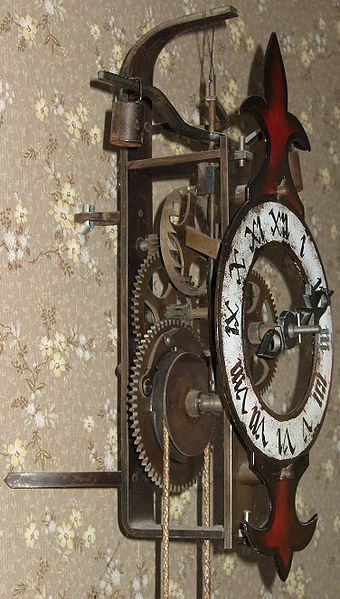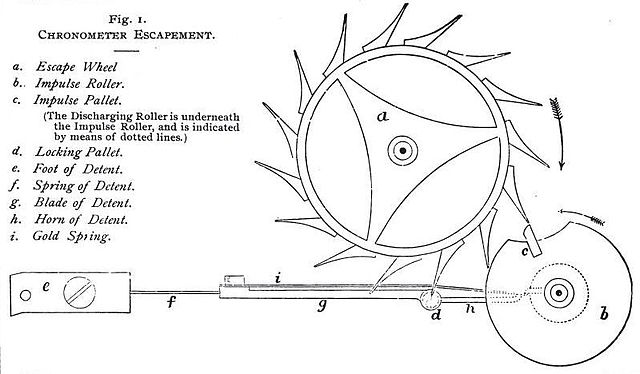The verge escapement is the earliest known type of mechanical escapement, the mechanism in a mechanical clock that controls its rate by allowing the gear train to advance at regular intervals or 'ticks'. Verge escapements were used from the late 13th century until the mid 19th century in clocks and pocketwatches. The name verge comes from the Latin virga, meaning stick or rod.
One of the earliest existing drawings of a verge escapement, in Giovanni de Dondi's astronomical clock, the Astrarium, built 1364, Padua, Italy. This had a balance wheel (crown shape at top) instead of a foliot. The escapement is just below it. From his 1364 clock treatise, Il Tractatus Astrarii.
Modern reproduction of an early verge and foliot clock. The pointed-tooth verge wheel is visible, with the wooden foliot rod and suspended weight above it.
Image: Salisbury Cathedral, medieval clock
Image: Salisbury Cathedral 2012 12
An escapement is a mechanical linkage in mechanical watches and clocks that gives impulses to the timekeeping element and periodically releases the gear train to move forward, advancing the clock's hands. The impulse action transfers energy to the clock's timekeeping element to replace the energy lost to friction during its cycle and keep the timekeeper oscillating. The escapement is driven by force from a coiled spring or a suspended weight, transmitted through the timepiece's gear train. Each swing of the pendulum or balance wheel releases a tooth of the escapement's escape wheel, allowing the clock's gear train to advance or "escape" by a fixed amount. This regular periodic advancement moves the clock's hands forward at a steady rate. At the same time, the tooth gives the timekeeping element a push, before another tooth catches on the escapement's pallet, returning the escapement to its "locked" state. The sudden stopping of the escapement's tooth is what generates the characteristic "ticking" sound heard in operating mechanical clocks and watches.

Original drawing from around 1637 of the pendulum clock designed by Galileo, incorporating the escapement.
Pin wheel escapement of South Mymms tower clock
First detent escapement by Pierre Le Roy 1748.
Earnshaw's detent escapement, used widely in chronometers.








